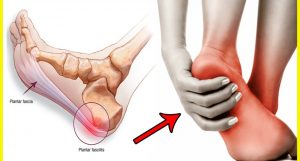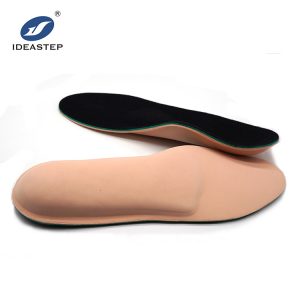Plantar Fasciitis
When you get up and go to the ground in the morning, the soles of your feet feel pain when you step on the ground, but after a few minutes of walking, the pain gradually disappears; after a long period of continuous or vigorous activity, the pain reappears; after sitting down to rest, stand up and walk. Pain reappears…
If you have such symptoms, be wary of plantar fasciitis!

What is Plantar Fasciitis?
A normal foot has an arch. Why is it called the arch of the foot?
Because it has a bowstring like a bow, and the bowstring of the arch of the foot is the plantar fascia. The place where plantar fasciitis is painful is the beginning or the middle of the plantar fascia. The arch of the foot is a human’s shock absorption system. When a person is walking, the arch of the foot will drop and rise to reduce the shock, and the plantar fascia will be repeatedly stretched. When excessive exercise or plantar fascia is aging, there will be partial tears at the beginning or midpoint of the fascia, forming a sterile inflammation, which is plantar fasciitis.
Plantar fasciitis is a common clinical disease. It is common in middle-aged and elderly people. The incidence rate is higher in groups with long-distance running or other sports habits, accounting for about 10%, far exceeding the general population. The typical clinical manifestations are heel pain, heel swelling, painful pressure, limp, and first-step walking pain in the morning.
In addition, plantar fasciitis is also the main cause of heel pain, which largely affects athletes’ training, competitive level, and even sports career, and inevitably reduces people’s quality of life.

woman holding her painful foot
Is plantar fasciitis an inflammation?
Although plantar fasciitis sounds like “inflammation”, it is not inflammation, but caused by degenerative changes in the tissues. The plantar fascia is a ribbon-like connective tissue located in the deep surface of the plantar fat layer, extending from the heel to the toe, and can be understood as a “rubber band” with a certain “elasticity”. When walking or exercising, the plantar fascia will shrink or stretch accordingly to provide the necessary support. If you exercise for a long time or with greater intensity, the plantar fascia, the “skin tendon”, will enter a state of fatigue due to overuse. Over time, degenerative changes in the soles occur.
What is the cause of plantar fasciitis?
As mentioned earlier, the root cause of plantar fasciitis is that the plantar fascia bears a force that exceeds its physiological limit for a long time. Such a long-term overload state leads to degeneration and fibrosis of the plantar fascia, leading to fascia inflammation.
In addition, in addition to excessive exercise or standing for a long time, high arch feet, flat feet, unequal length of the lower limbs, the improper wearing of shoes (especially high heels or shoes with thin soles), etc. may all induce plantar fasciitis. Therefore, plantar fasciitis is more common in athletes, women, soldiers, and obese people. In addition, as the age grows, the elasticity of the plantar fascia will correspondingly decrease, so more damage occurs. Therefore, plantar fasciitis has a higher incidence in people aged 40-60.

Why does plantar pain when I get up early?
The most common symptom of plantar fasciitis is the pain and discomfort of the heel and sole, especially the first step in the morning to get out of bed. This is because the plantar fascia is a “rubber band”. After a night of relaxation, rest and adjustment, the plantar fascia no longer bears weight and is in a relatively contracted state. Once the plantar fascia that has not yet recovered its elasticity is pulled down suddenly, it will cause obvious pain.
This phenomenon is called priming pain.
Next, after walking for a while, the plantar fascia will loosen accordingly, so that the symptoms can be relieved. However, if followed by long-distance, high-intensity exercise, or wearing shoes that do not fit the feet, the plantar fascia will be stretched and contracted too strongly, which will cause the corresponding pain to reappear.
Plantar fasciitis may even hurt every step of the way in the middle stage. In the later stage, due to repeated inflammation and stimulation of the plantar fascia, calcification foci of the plantar fascia will be formed at the position of the calcaneus, which is what we often call the calcaneal spur. However, bone spurs are not the cause of the pain, the real cause is the chronic inflammation of the plantar fascia. Therefore, even if the bone spur is cut through surgery, the pain will still be painful.
How is plantar fasciitis treated?
Generally speaking, in the acute phase of plantar fasciitis, the PRICE principle is used to deal with it, namely protection (protection of the injured part), rest (rest), ice (ice), compression (compression bandaging), elevation (elevation limbs).
For the treatment of plantar fasciitis, there are generally traditional methods such as surgery and medication. However, the medication can only relieve the pain. After the medication has passed, it still hurts and it is of no use. Surgery is also not suitable, there is nothing to do. If you think about it, the key is to let the damaged fascia no longer be pulled and fully repair it.
Not stepping on the ground for a long time is indeed one way, but it is not realistic. If you don’t step on the ground for three months, your calf muscles will atrophy.
Therefore, the best way is to use professional biomechanical orthopedic insoles for conservative treatment. Through accurate data measurement, a personalized customized insole is created for the patient to allow the patient to restore the arch of the foot, thereby reducing the traction on the plantar fascia, thereby alleviating pain and promoting the recovery of damaged tissues.
This method is effective for most patients, the effect is definite, and it is safer than taking medicine. With insoles, you can also work and live normally without affecting anything. It is the most rational treatment!
In addition, certain rehabilitation training can help the function of the affected area’s fascia and muscles to recover, and can effectively prevent the recurrence of plantar fasciitis.


https://aideastep.com/plantar-fasciitis-insoles-2/
https://aideastep.com/orthotics-for-plantar-fasciitis/
Hot blogs:
The Easiest Custom Insoles: Heat Moldable Insoles
Custom insoles, also known as orthotic insoles, are designed to provide personalized support and comfort for individuals with various foot conditions. In [...]
Children’s Insole Size Conversion Chart
The standard sizes for shoe insoles may vary from country to country, making it a headache to choose the right insole for [...]
Do custom orthotics need to be made by a doctor personally?
Custom orthotics do not necessarily need to be made by a doctor personally. While doctors, specifically podiatrists or orthopedic specialists, are often [...]
Do NBA players use custom insoles?
Custom insoles are not only helpful for people with foot health issues, but they also play a significant role in targeting the [...]
